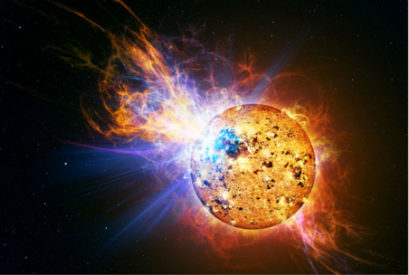- Series:Astronomy, Transcript English
Psalm 19:1
“The heavens declare the glory of God; and the firmament sheweth his handywork.”
 We have discussed in previous Creation Moments how those who believe in the Big Bang Theory (let’s call them Big Bang Believers) have a sophisticated model of star formation into which they plug a number of interesting observations which could easily be interpreted in another way. For example, they would claim that certain gas molecule clouds, such as the Eagle Nebula, which contain small, bright stars, are, in fact, nurseries where stars are born. They then make the claim that they have observational evidence for the birth of stars, but this is, logically, a circular argument. The observed nebula is interpreted as the birth of stars only because it is interpreted according to their Big Bang Belief. The nebula cannot then be offered up as evidential proof for the very theory which is used to interpret it.
We have discussed in previous Creation Moments how those who believe in the Big Bang Theory (let’s call them Big Bang Believers) have a sophisticated model of star formation into which they plug a number of interesting observations which could easily be interpreted in another way. For example, they would claim that certain gas molecule clouds, such as the Eagle Nebula, which contain small, bright stars, are, in fact, nurseries where stars are born. They then make the claim that they have observational evidence for the birth of stars, but this is, logically, a circular argument. The observed nebula is interpreted as the birth of stars only because it is interpreted according to their Big Bang Belief. The nebula cannot then be offered up as evidential proof for the very theory which is used to interpret it.
In a similar manner, Big Bang Believers have a theory of planetary formation. In most cases, they assume that a cloud of gas and dust orbits the newly formed star and that, following a disturbance by something such as another star passing by, clumps of rock begin to aggregate under gravity until planet-sized lumps are formed.
One cloud of gas was recently reported as emanating from an observed star 685 light years away. The star has an evolutionary age of 2 million years. But what was actually observed is a large stellar flare. A Big Bang interpretation does not constitute proof and cannot undermine the Scriptural position that God made such objects on Day Four.
Prayer: Once again, we give You glory, Lord God Almighty, for the evidence of Your mighty hand at work in Your heavens. Amen.
Author: Paul F. Taylor
Ref: University of Warwick. “Baby star’s fiery tantrum could create the building blocks of planets.” ScienceDaily, 21 December 2018. <www.sciencedaily.com/releases/2018/12/181221123729.htm>. Image: Stellar Flare, NASA image, Public Domain.
© 2019 Creation Moments All rights reserved.
